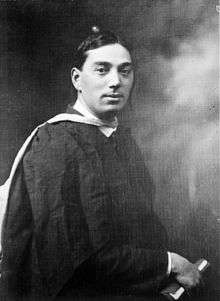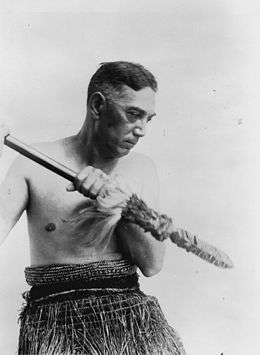Te Rangi Hīroa
Sir Peter Henry Buck KCMG DSO (ca. October 1877 – 1 December 1951), also known as Te Rangi Hīroa or Te Rangihīroa, was a New Zealand doctor, military leader, health administrator, politician, anthropologist and museum director. He was a prominent member of Ngāti Mutunga, his mother's Māori iwi.
Sir Peter Buck KCMG DSO | |
|---|---|
Te Rangi Hīroa | |
.jpg) Te Rangi Hīroa in 1927 | |
| Born | Peter Henry Buck c. October 1877 |
| Died | 1 December 1951 (aged 74) Honolulu, Hawaii, USA |
| Nationality | New Zealand |
| Occupation | Anthropologist, politician, doctor |
Early life
Peter Buck was born in Urenui, New Zealand, the only child of Anglo-Irish immigrant William Henry Buck and Rina, a Māori woman. William's wife Ngarongo-ki-tua had been unable to have children and, in line with Māori custom, Rina, one of Ngarongo's relatives, became part of the household and produced a child for the couple. Rina died soon after Peter was born, and Ngarongo raised him as her own. He claimed to have been born in 1880, but the register of the primary school he attended records October 1877, which is likely to be correct.[1]

Te Rangi Hīroa was descended on his Māori (maternal) side from the Taranaki iwi of Ngāti Mutunga. In his teens,[2] his elders gave him the name Te Rangi Hīroa (also written Te Rangihiroa) in honour of an uncle of Ngarongo's and an earlier notable ancestor. His paternal ancestry was English and Irish. Though he was largely brought up within the Pākehā (the Maori term for non-Maori people, Caucasian people in particular) community, Ngarongo-ki-tua and his great-aunt Kapuakore instilled a love of Māori tradition and language in him.[1]
After Ngarongo's death in 1892 he moved with his father to the Wairarapa. In 1896 he started attending Te Aute College, a school that produced many Māori leaders of the time. In 1899 he was named Dux and passed a medical preliminary examination, entitling him to attend the University of Otago Medical School. He was later associated with the Young Māori Party.
Medical school and practice
Buck did well at Otago Medical School, where he also succeeded in sport, becoming national long jump champion in 1900 and 1903. He completed his MB ChB in 1904, and an MD six years later. During this time, in 1905, he married Irish-born Margaret Wilson. Their long marriage was often fiery, but was strong, and it was Margaret who often gave the impetus to Peter's career.
In November 1905 Buck was appointed as a medical officer to Māori, working under Māui Pōmare, initially in the southern North Island, then in the far north. Between them Pomare and Buck campaigned successfully to improve sanitation in the small Māori communities around the country.
Parliament and war
| New Zealand Parliament | ||||
| Years | Term | Electorate | Party | |
| 1909–1911 | 17th | Northern Maori | Liberal | |
| 1911–1914 | 18th | Northern Maori | Liberal | |
In 1909, Hone Heke Ngapua, Member of Parliament for Northern Maori died suddenly. Buck was singled out by Native Minister James Carroll to be his replacement. Buck accepted and was elected in the subsequent by-election.[4] He became a member of the Native Affairs Committee. He did not seek re-election to the seat in 1914, but stood for the Bay of Islands electorate, where he lost with a narrow margin.[5] By this time, Buck had developed an interest in Pacific Island peoples, working briefly as a medical officer in both the Cook Islands and Niue during parliamentary breaks.
During the First World War, Buck helped in the recruitment of a Māori volunteer contingent. Buck joined this contingent as medical officer, travelling to the Middle East in 1915. He took part at Gallipoli, later being awarded a Distinguished Service Order for his heroism. He later saw action in France and Belgium, before being posted to the No 3 New Zealand General Hospital at Codford, England, in 1918.
Returning to New Zealand, Buck was appointed as Chief Maori Medical Officer, and in 1921 was named director of the Maori Hygiene Division in the Department of Health.
Bishop Museum
.jpg)
Buck gained a five-year research fellowship at the Bishop Museum in Honolulu, Hawaii, in 1927. At the end of the fellowship in 1932 he was appointed Bishop Museum visiting professor of anthropology at Yale University. He was promoted to Director of the Bishop Museum in 1936, a position he held until his death in 1951. He also served as a Trustee and President of the Board of Trustees of the museum.[1]
Awards and tributes
In 1935, he was awarded the King George V Silver Jubilee Medal.[6] In the 1946 King's Birthday Honours, Buck was appointed a Knight Commander of the Order of St Michael and St George for services to science and literature.[7]
The Te Rangi Hiroa Medal is a social sciences award given biennially by the Royal Society of New Zealand. It is awarded for work in one of four disciplines: historical approaches to societal transformation and change; current issues in cultural diversity and cohesion; social and economic policy and development; and medical anthropology.[8]
One of the residential colleges of the University of Otago is named Te Rangi Hīroa College in his honour.[9]
Bibliography
- Buck, Peter (1910), Medicine amongst the Maoris in ancient and modern times: a thesis for the degree of Doctor of Medicine (N.Z.)
- Buck, Peter (1911), Takiwa pooti o te Tai-Tokerau, Wellington, N.Z.: N.Z. Times Print
- Buck, Peter (1923), Maori plaited basketry and plaitwork. 1, Mats, baskets, and burden-carriers, Wellington, N.Z.: Government Printer
- Buck, Peter (1924), Maori plaited basketry and plaitwork. 2, Belts and bands, fire-fans and fly-flaps, sandals and sails, Wellington, N.Z.: Government Printer
- Buck, Peter (1925), The coming of the Maori, Nelson, N.Z.: R. W. Stiles
- Buck, Peter (1926), The evolution of Maori clothing (Memoirs of the Polynesian Society ; v. 7), New Plymouth, N.Z.: Printed by Thomas Avery, under the authority of the Board of Maori Ethnological Research
- Buck, Peter (1926), The Maori craft of netting, Wellington, N.Z.: Government Printer
- Buck, Peter (1927), The material culture of the Cook Islands (Aitutaki) [Memoirs of the Board of Maori Ethnological Research ; v. 1], New Plymouth, N.Z.: Printed by Thomas Avery, under the authority of the Board of Maori Ethnological Research
- Buck, Peter (1929), The coming of the Maori (2nd ed.), Nelson, N.Z. ; New Plymouth N.Z.: Cawthron Institute ; Thomas Avery & Sons
- Buck, Peter (1930), Samoan material culture (Bernice P. Bishop Museum bulletin ; 75), Honolulu, HI.: Bernice P. Bishop Museum
- Buck, Peter (1932), Ethnology of Manihiki and Rakahanga (Bernice P. Bishop Museum bulletin ; 99), Honolulu, HI.: Bernice P. Bishop Museum, retrieved 27 April 2008
- Buck, Peter (1932), Ethnology of Tongareva (Bernice P. Bishop Museum bulletin ; 92), Honolulu, HI.: Bernice P. Bishop Museum, retrieved 27 April 2008
- Buck, Peter (1938), Ethnology of Mangareva (Bernice P. Bishop Museum bulletin ; 157), Honolulu, HI.: Bernice P. Bishop Museum
- Buck, Peter (1934), Mangaian society (Bernice P. Bishop Museum bulletin ; 122), Honolulu, HI.: Bernice P. Bishop Museum
- Buck, Peter (1936), Regional diversity in the elaboration of sorcery in Polynesia (Yale University publications in anthropology ; no. 2), New Haven, CT.: Published for the Section of Anthropology, Dept. of the Social Sciences, Yale University by the Yale University Press
- Buck, Peter (1939), Anthropology and religion, New Haven, CT.: Yale University Press
- Buck, Peter (1940), "Native races need not die", Asia, 40 (7): 379–382
- Buck, Peter (1944), Arts and crafts of the Cook Islands (Bernice P. Bishop Museum bulletin ; 179), Honolulu, HI.: Bernice P. Bishop Museum
- Buck, Peter (1945), An introduction to Polynesian anthropology (Bernice P. Bishop Museum bulletin ; 187.), Honolulu, HI.: Bernice P. Bishop Museum, retrieved 27 April 2008
- The voice of Sir Apirana T. Ngata ; The voices of Sir Peter (Te Rangihiroa) Buck, Bishop Frederick Augustus Bennett (Bishop of Aotearoa), Te Puea Herangi [sound recording] (HMV PR-9) 10-inch / 78rpm, Wellington, N.Z.: His Master's Voice, 1949
- Buck, Peter (1950), Material culture of Kapingamarangi (Bernice P. Bishop Museum bulletin ; 200), Honolulu, HI.: Bernice P. Bishop Museum
- Buck, Peter (1950), The coming of the Maori (2nd ed.), Wellington, N.Z.: Māori Purposes Fund Board ; Whitcombe & Tombs
- Buck, Peter (1952), Les migrations des Polynesians: les Vikings du soleil levant (The Vikings of the sunrise) [Bibliotheque scientifique], Paris, France: Payot
- Buck, Peter (1953), Explorers of the Pacific: European and American discoveries in Polynesia (Bernice P. Bishop Museum special publication ; 43), Honolulu, HI.: Bernice P. Bishop Museum?, retrieved 27 April 2008
- Buck, Peter (1954), The Vikings of the sunrise (New Zealand ed.), Christchurch, N.Z.: Whitcombe & Tombs
- Buck, Peter (1957), Arts and crafts of Hawaii (Bernice P. Bishop Museum special publication ; 45), Honolulu, HI.: Bernice P. Bishop Museum Press
- Buck, Peter (1959), The Vikings of the Pacific, Chicago, IL.: University of Chicago Press
- Buck, Peter (1970), Anthropology and religion, Hamden, CT.: Archon Books
- Buck, Peter (1976), The material culture of the Cook Islands (Aitutaki), New York, NY.: AMS Press
- Buck, Peter (1993), Mangaia and the mission, Suva, Fiji: IPS, USP in association with Bernice P. Bishop Museum, ISBN 982-315-001-X
- Sorrenson, M.P.K. (ed.) (1986–1988), Na to hoa aroha = From your dear friend: the correspondence between Sir Āpirana Ngata and Te Rangi Hīroa, 1925–50 (3 vol.), Auckland, N.Z.: Auckland University Press in association with the Alexander Turnbull Library Endowment Trust and the Māori Purposes Fund BoardCS1 maint: extra text: authors list (link)
Footnotes
- Sorrenson, M. P. K. (1 September 2010). "Buck, Peter Henry - Biography". Dictionary of New Zealand Biography. Retrieved 11 December 2010.
- Beaglehole, Ernest (1966). "Buck, Sir Peter Henry (Te Rangihiroa), K.C.M.G., D.S.O.". In McLintock, A.H. (ed.). An Encyclopaedia of New Zealand. Retrieved 1 September 2019 – via Te Ara – the Encyclopedia of New Zealand.
- Photograph by kind permission of the Alexander Turnbull Library, Wellington, New Zealand, reference number: 1/2-078259-F
- Wilson, James Oakley (1985) [First ed. published 1913]. New Zealand Parliamentary Record, 1840–1984 (4th ed.). Wellington: V.R. Ward, Govt. Printer. OCLC 154283103.
- "Other contests". The Evening Post. LXXXVIII (141). 11 December 1914. p. 3. Retrieved 11 December 2010.
- "Official jubilee medals". The Evening Post. 6 May 1935. p. 4. Retrieved 2 July 2013.
- "No. 37601". The London Gazette (Supplement). 13 June 1946. p. 2835.
- "Te Rangi Hiroa Medal". Royal Society of New Zealand. Retrieved 1 September 2019.
- "Te Rangi Hiroa College – History". University of Otago. Retrieved 4 September 2019.
Further reading
- Boon, Kevin (c. 1996), Peter Buck, Wellington,N.Z: Kotuku Pub., ISBN 0-908947-16-X
- Condliffe, J. B. (1971), Te Rangi Hiroa: the life of Sir Peter Buck, Christchurch, N.Z.: Whitcombe & Tombs, ISBN 0-7233-0316-9
- Ramsden, Eric (1954), A memoir -- Te Rangihiroa: memorial to Sir Peter Buck, Wellington, N.Z.: Dept. of Maori Affairs
- Sorrenson, M. P. K., Buck, Peter Henry 1877?-1951 Dictionary of New Zealand Biography, updated 7 April 2006., retrieved 27 April 2008
External links
- eTexts of books (5) by Te Rangi Hīroa
- Otago University: Te Rangi Hīroa (alumni profile)
- Military Personnel File online; digitised record at Archives New Zealand.
| New Zealand Parliament | ||
|---|---|---|
| Preceded by Hone Heke Ngapua |
Member of Parliament for Northern Maori 1909–1914 |
Succeeded by Taurekareka Henare |
